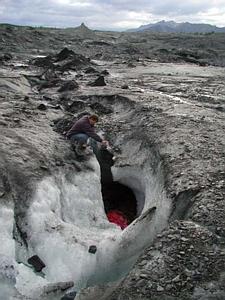27 July, 2000
July 27, 2000
Matanuska Glacier, Alaska
This has turned out to be perhaps the busiest day yet. There are more
people than ever in camp now and one person who arrived yesterday was
Bob Bigl. Bob will be drilling holes in the ice and collecting data from
those holes. At one time we thought that we would try some dye tests
with a few of these holes. In addition to Bob, my principal investigator
Ed Evenson has been here for the past three days to see how things were
going and to lend some insight into the project. The entire morning was
spent walking around the glacier discussing possible bore sites and
strategies with Ed, Bob and Jeff Strasser. Over the next two weeks Bob
will be relying on the help of everyone in camp to move and set up his
drilling rig at different sites. It looks like even busier days are on
the horizon.
After some discussion it was decided that one of the REU students, Isaac
Larsen, will conduct the dye study in the drilled holes for his project.
Ben and I have only two weeks left before we head back to our homes and
it was felt that there wouldn’t be enough time to complete the moulin
study and also test the bore holes.We will be working closely with Isaac
to get him started since he will essentially be doing what we are but
with man-made holes instead of natural moulins. His work should help us
in our study because his dye will be infused directly into the
subglacial drainage system. Our dye must make its way down through the
englacial drainage system (within the ice) before reaching the
subglacial drainage (below the ice). By looking at his results we may be
able to determine what happens to the dye before it reaches the
subglacial system.
We will continue to investigate the connections and flows of dye from
the moulin we have used in previous dye tests. Tonight at 8:00 pm we
went out to the ice to reprogram three ISCO water samplers. This time we
wanted to take samples from all three Mammoth vents that were previously
sampled on different days. We poured the dye at 9:00 pm and took samples
every ten minutes for four hours. The flow rate into the moulin should
be at or near the maximum for a 24 hour period due to the warm sunny
daylight hours. We are then going to get up early tomorrow morning and
head out to retrieve the samples, place new sample racks in the ISCOs
and reprogram them. We will then pour into the moulin again at 9:00 am.
These samples should tell us what’s going on at all three vents during
low flow resulting from cooler night time conditions.
Marvin Giesting

Pouring the dye into the moulin once again. Look at the picture of this same moulin in the July 20 journal to get an idea of how much it has changed in one week.

We enjoy the fluorescence of the dye in the stream feeding the moulin when we rinse out the bottle. It's amazing how the little bit left in the bottle can cause the stream to get so bright, about like a huge Glo-stick. The dye is so diluted by the time it comes out the vent that you cannot detect it with your eyes.
Contact the TEA in the field at
.
If you cannot connect through your browser, copy the
TEA's e-mail address in the "To:" line of
your favorite e-mail package.
|
